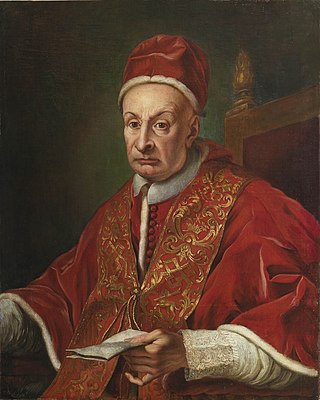
Pope Benedict XIII, born Pietro Francesco Orsini and later called Vincenzo Maria Orsini, was head of the Catholic Church and ruler of the Papal States from 29 May 1724 to his death in February 1730.

Pope Clement XII, born Lorenzo Corsini, was head of the Catholic Church and ruler of the Papal States from 12 July 1730 to his death in February 1740.
Papabile is an unofficial Italian term first coined by Vaticanologists and now used internationally in many languages to describe a Catholic man, in practice always a cardinal, who is thought a likely or possible candidate to be elected pope.
Jus exclusivae was the right claimed by several Catholic monarchs of Europe to veto a candidate for the papacy. Although never formally recognized by the Catholic Church, the monarchs of France, Spain and Austria claimed this right at various times, making known to a papal conclave, through a crown-cardinal, that the monarch deemed a particular candidate for the papacy objectionable.
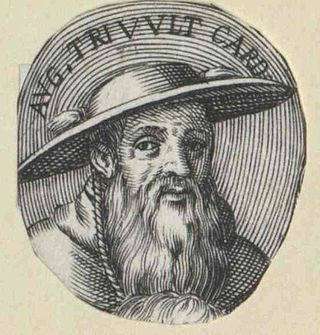
Agostino Trivulzio was an Italian Cardinal and papal legate. He was from a noble family in Milan, the eighth child of Giovanni Trivulzio di Borgomanero, a Councillor of the Dukes of Milan, and Angela Martinengo of Brescia, and was the nephew of Cardinal Gianantonio Trivulzio (1500–1508). Another uncle, Cardinal Antonio's brother Teodoro, was Governor of La Palice, of Genoa, of Milan, and a Marshal of France. Giovanni and Angela had a daughter named Damigella or Domtilla who was famous for her learning. Cardinal Agostino Trivulzio had a nephew named Giovanni, who married Laura Gonzaga.
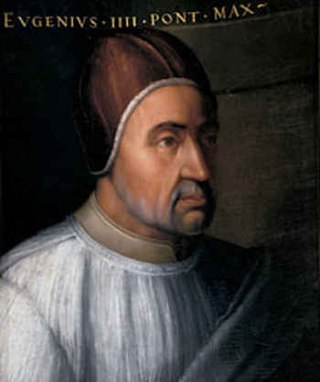
The 1431 papal conclave convened after the death of Pope Martin V and elected as his successor Cardinal Gabriele Condulmer, who took the name Eugene IV. It was the first papal conclave held after the end of the Great Western Schism.

The 1758 papal conclave, convoked after the death of Pope Benedict XIV, elected Cardinal Carlo Rezzonico of Venice, who took the name Clement XIII.

The April 1555 papal conclave was convoked after the death of Pope Julius III. Cardinals at the conclave generally grouped themselves into three major factions, according to their alignment with the French House of Valois, the Hapsburgs, or Italian states that remained independent of both major Catholic powers. After preparing a conclave capitulation that compelled whichever cardinal was elected pope to maintain neutrality in European wars, cardinals from the Holy Roman Empire joined in supporting the French faction's candidate, Cardinal Marcello Cervini. Cervini was elected Julius's successor, and chose to maintain his baptismal (birth) name as his papal name, becoming consecrated as Marcellus II.

The 1721 papal conclave, convoked after the death of Pope Clement XI, elected Cardinal Michelangelo de' Conti, who took the name of Innocent XIII.

The 1774–75 papal conclave, was convoked after the death of Pope Clement XIV and ended with the election of Cardinal Giovanni Angelo Braschi, who took the name of Pius VI.
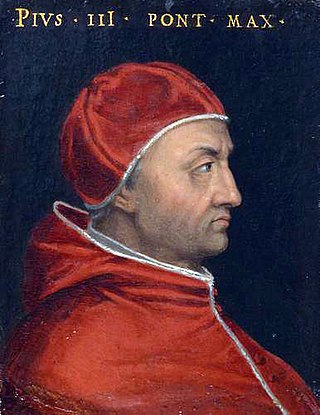
The September 1503 papal conclave elected Pope Pius III to succeed Pope Alexander VI. Due to the Italian Wars, the College of Cardinals was surrounded by three potentially hostile armies, loyal to Louis XII of France, Ferdinand II of Aragon, and Cesare Borgia.

The October 1503 papal conclave elected Cardinal Giuliano della Rovere as Pope Julius II to succeed Pope Pius III. The conclave took place during the Italian Wars barely a month after the papal conclave, September 1503, and none of the electors had travelled far enough from Rome to miss the conclave. The number of participating cardinals was thirty-eight, the College of Cardinals having been reduced by the election of Piccolomini as Pius III, who did not elevate cardinals. At a consistory on 11 October Pope Pius had proposed to make Cardinal d'Amboise's nephew a cardinal, as part of his effort to conciliate the French, but the response from the cardinals was not enthusiastic.
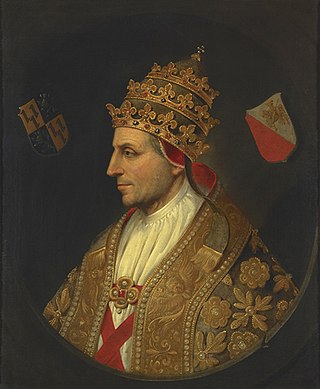
The 1521–22 papal conclave elected Pope Adrian VI to succeed Pope Leo X. The conclave was marked by the early candidacies of cardinal-nephew Giulio de'Medici and Alessandro Farnese, although the Colonna and other cardinals blocked their election.

Neri Maria Corsini was an Italian nobleman and Catholic priest and cardinal.

The 1740 papal conclave, convoked after the death of Pope Clement XII on 6 February 1740, was one of the longest conclaves since the 13th century.

The 1724 papal conclave was called upon the death of Pope Innocent XIII. It began on 20 March 1724 and ended on 28 May that year with the election of Cardinal Vincenzo Maria Orsini, a Dominican friar, as Pope Benedict XIII. The conclave was made of largely the same electors that had elected Innocent in 1721 and the same factions dominated it. Multiple attempts were made to elect candidates that would be acceptable to the various Catholic monarchies at the time, but none were successful until May. Benedict resisted his own election for two days before being convinced to accept it.

The 1565–66 papal conclave was convened on the death of Pope Pius IV and ended in the election of Pope Pius V.

Giuseppe Renato Imperiali was an Italian cardinal, and known as an avid bibliophile.

Pietro Marcellino Corradini was an Italian Roman Catholic cardinal. Corradini served in various departments of the Roman Curia under several popes and founded the Collegine Sisters of the Holy Family as a response to the demand for religious instruction for girls.

Troiano Acquaviva of Aragon was an Italian cardinal and Catholic archbishop. Acquaviva was from a noble family with close ties to the Spanish crown; he was the nephew of Cardinal Francesco Acquaviva d'Aragona. Created cardinal in 1732, the following year he became cardinal-protector of Santa Cecilia in Trastevere, for which he provided a new façade. In 1734 King Philip V of Spain appointed him Spanish ambassador to the Holy See.

















